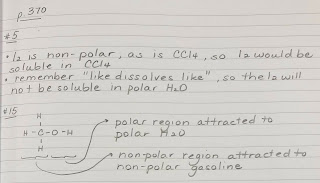The
rate of dissolution of a solute in a solvent is dependent on three factors:
- temperature – at higher temperatures, the solvent molecules have a higher kinetic energy and will collide with the solute particles more often (rate ↑)
- agitation – stirring or shaking a solution brings more solvent particles into contact with the solute particles (rate ↑)
- surface area – crushing or breaking up the solute will increase the area of interface between solute and solvent (rate ↑)
Solubility & Particle Attractions
Solute
particles are held together by forces of attraction - there must be an energy
input to break these forces of attraction.
Solvent
particles are held together by forces of attraction - there must be an energy
input to break these forces of attraction.
When the solute and solvent are mixed to create a solution, there is the force of attraction between solute particles and solvent particles – this usually
results in an energy output.
 |
| A substance is more likely to dissolve if the energy output is greater than the energy input (i.e., an exothermic dissolution). |
Polar & Non-polar Substances
Polar
solutes dissolve in polar solvents & non- polar solutes dissolve in
non-polar solvents.
- This is why alcohol dissolves in water - they are both polar.
- This is why oil dissolves in gasoline - they are both non-polar.
- This is why oil and water don't mix - one is non-polar and the other is polar.
Just remember “like
dissolves like.”
Dipole-Dipole Attractions
A dipole-dipole attraction or dipole-dipole force operates between two neutral, polar molecules.
Recall that polar molecules have a ẟ+ end and a ẟ- end. When two polar molecules are in close proximity to each
other, the ẟ+ end of one molecule is attracted to the ẟ- end of its neighbour. This attraction is called a dipole-dipole force.
ẟ+ H-Cl ẟ-⎹⎹⎹⎹⎹ ẟ+ H-Cl ẟ-
Hydrogen bonding is a special form of dipole-dipole force. Although it operates in the same way as a dipole-dipole force, the molecule must contain a H atom bonded directly to a F, O or N atom. Water, as seen below, can undergo hydrogen bonding because it has H bonded to O. The atoms directly involved in the H-bond can be designated as the "hydrogen bond acceptor" (this is always a F, O or N from one molecule) or the "hydrogen bond donor" (this is always the H atom from a neighbouring molecule).
Tryit!: Show all the unique hydrogen bonds within a water and ammonia mixture. Label the hydrogen bond acceptor in each case. The answer is at the end of the lesson.
Ion-Dipole Attractions
When
an ionic compound comes in contact with water, the water molecules pull out the
ions and surround them in solution.
Answer for the Tryit!
Homework: Review Questions, p. 370 # 2, 3, 5, 7, 14, 15
Student Questions:
1. Please explain p. 370 # 5, 15.




